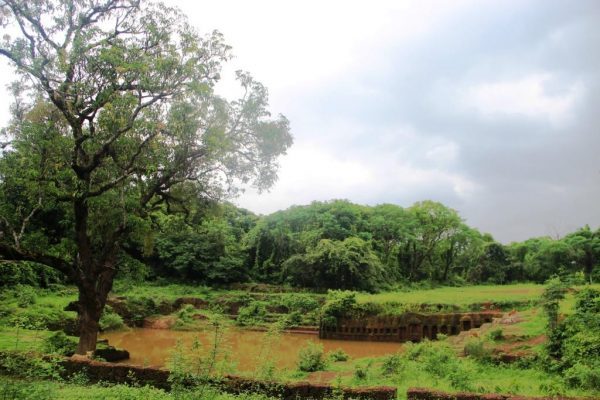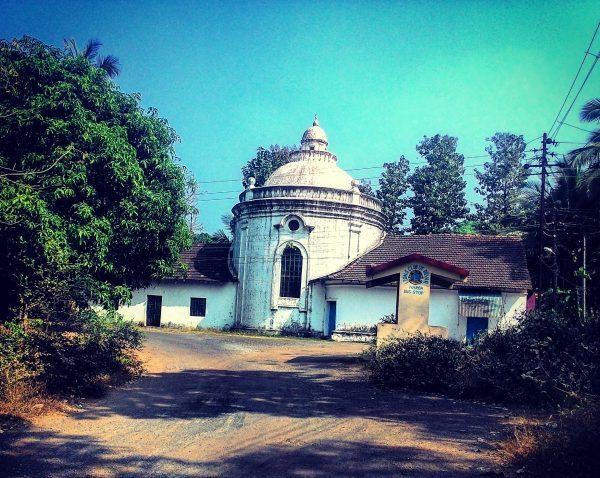Naroa is a small village located on the easternmost tip of Divar. It claims to be a blessed village due to its location at the confluence of three branches of the Mandovi river. The Hindus referred to it as ‘tirth’ (holy water) which they believed washed away their sins after a dip in it.
Naroa, an ancient village
Naroa is possibly one of Goa’s tiniest villages with a population of 1000 people (80 houses). The village was a bustling one in the ancient days but today, with the onslaught of modernization, it lies in danger of being lost forever. A businessman said to be from Calangute runs a prawn farming unit in Naroa. There is also a fiber speedboat manufacturing unit in the village. These speedboats are even exported elsewhere. Naroa is also the site of sand extraction with trucks regularly coming and going from Divar.
The lure of better prospects abroad has lured most of Naroa’s Catholic youth. The village is full of pretty houses but most of these remain closed as their owners have chosen to move to the UK and other countries.
The Saptakoteshwar Temple
The village was also home to the Saptakoteshwar temple, held in high reverence by the Hindu population and visited by pilgrims from far and wide. This temple was originally constructed in the 12th century during the Kadamba dynasty. However, it was destroyed by the Deccan Sultanate in the 14th century and later reconstructed in the same location after the Sultan of Deccan was overthrown. Later, when the Portuguese colonized Goa, the temple was destroyed once again.
This was a common occurrence during Portuguese rule. Every temple that existed in Goa was destroyed. Of course, a brave few managed to smuggle away ancient artifacts of great value and hide them in unknown locations. Take the Shivalinga from the Naroa temple. After being taken away for safekeeping, it was placed on the wall of a village well where it existed for years. To this day, it still bears the marks made by the vessels used for drawing water during that time.
Chapel of Our Lady of Candelaria
The old ruins of the Saptakoteshwar temple became the foundation upon which a small prayer and catechism house were constructed in 1543. A year later, the Chapel of Our Lady of Candelaria was constructed. It has an unusual feature in the form of a domed roof. This can only be found in 2 other chapels in Goa.
Fortress and the Church dedicated to St. Thomas the Apostle
Given the Portuguese influences in Goa, one cannot go anywhere without coming upon a church. The ferry wharf connecting Divar to Bicholim was once upon a time a hostile place. The war between the Portuguese and the kingdom of Bijapur raged constantly. A fortress was built to guard this entrance. The fortress lies in ruins today but the small church attached to it serves the locals in Naroa.
There is an interesting story about why the church was built. The Jesuit priest Moren de Souza writes about the history of the Naroa church in his book Tisvaddecheo Igorzo (Churches of Tiswadi):
“During a routine inspection, one Portuguese commander found the fortress of Naroa practically empty. It seemed that being a Sunday, the entire garrison had gone to a neighboring church for Sunday services. To solve this problem, the officials decided to construct a church there. Accordingly, the king of Portugal wrote a letter dated 8th March 1546 to Dom Joao de Castro and instructed him to build a church at Naroa and dedicate it to St. Thomas the Apostle. A document dated in the year 1710 reveals that Diogo da Silveira, captain of the fort of Naroa built this church. Though the church is dedicated to the Holy Spirit, a statue of St Thomas adorns the main altar.” (Source: Wikipedia)
Tarir’s Riverside Cross
Another unusual sight one will see in Naroa is the Tarir Riverside Cross. Built by the fisherfolk of this particular ward, Tarir, it is one that is held in great faith. It is said that fishermen would stand up in their canoes while in the water and sing the litany. They believe that if the cross ever gets submerged, water will enter into their houses as well. Therefore, they sing the litany to protect their homes from getting flooded.
The Porne Tirth
Naroa is also famous for its Porne Tirth. An ancient spring that was eventually turned into a water tank with a myriad of carvings on the laterite wall enclosing it. These decorative recesses resemble those of Buddhist shrines. It is the only site that has attracted any kind of government attention. This tank which was buried under debris was recently excavated and cleaned. A small board proclaims it to be a ‘protected site’.

Image credit – The Local Beat
Information credit
ItsGoa/JULY/KDGP


